With a nickname of ‘corn country’, it shouldn’t come as a surprise that Indiana is known more for its farmland than its National Parks. Having said that, if you know where to look, beautiful rivers, charming forests, and abundant historical sites are just waiting to be explored. With some local knowledge and a sense of adventure, there’s plenty of wilderness for everyone to enjoy.
In fact, Indiana is home to three unique National Park sites. The most well-known is the Indiana Dunes National Park. Located just outside of Chicago, it’s a great place to get away for the day or weekend, swim in Lake Michigan and bike or hike along one of its many paved trails. If you prefer history over hiking, the George Rogers Clark National Historical Park and Lincoln Boyhood National Memorial take you on a journey back in time to America’s early days.
Whether you’re just passing through or have some time up your sleeve to explore, Indiana has plenty of well-kept trails and intriguing history to keep everyone entertained. Keep reading to learn about our favourite must-do’s and key features of Indiana’s National Parks, and we promise you won’t think of Indiana as only corn country ever again.
Contents
Indiana National Parks
1- Indiana Dunes National Park
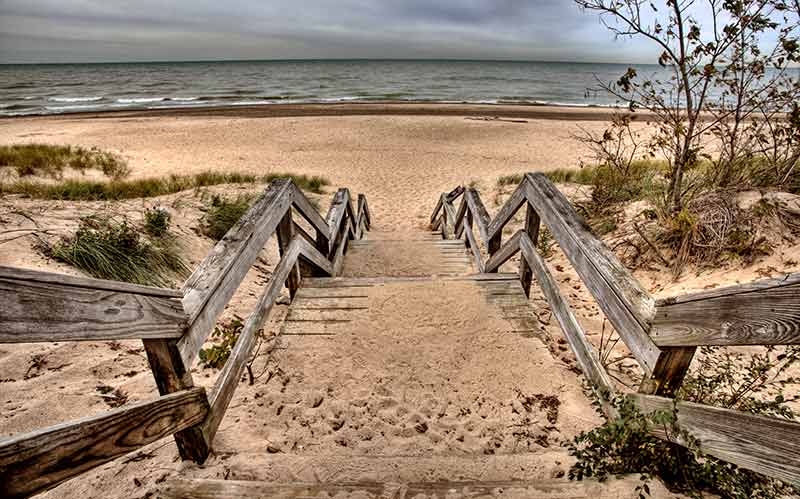
Home to 15,000 acres (6,070 hectares) of rugged dunes, wildlife-filled wetlands, meandering rivers, lush forests, charming prairies and picture-perfect beaches, Indiana Dunes National Park has something for every type of explorer.
Located in northern Indiana, just 35 miles (56 kilometres) from Chicago, it’s the ideal place to escape the city for a day and enjoy a hike and a swim.
Or, if you have a full weekend or longer up your sleeve, settle in and enjoy the park’s slower-paced life.
Things To Do In Indiana Dunes National Park
Before setting off on your first activity, it’s always best to first stop at the Indiana Dunes National Park Visitor Center.
Here you can learn about the must-see spots, hear about any special events or closures that may affect your trip, and purchase your entry pass.
Head To The Beach
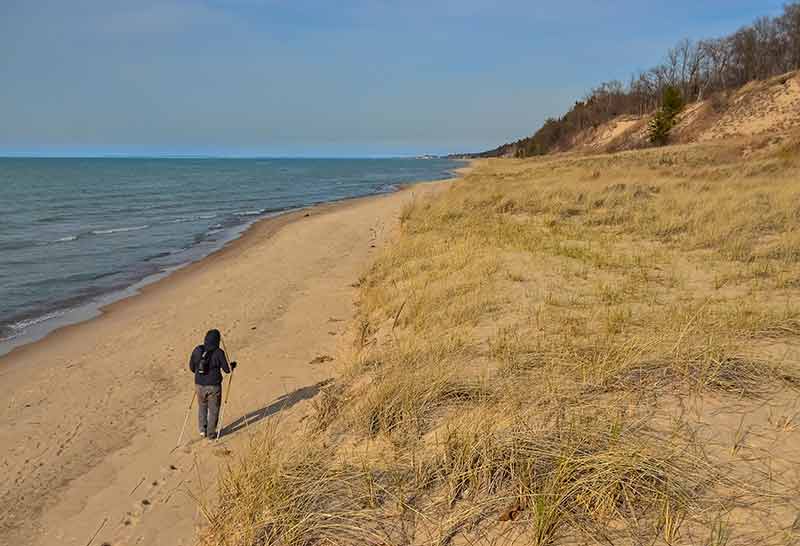
No trip to Indiana Dunes National Park is complete without a stop at one of the many beaches.
With 15 miles (24 kilometres) of shoreline along the southern edge of Lake Michigan, you’ll easily be able to find your own slice of paradise and post up for as long as your heart desires.
One of the best beaches on a hot summer day is West Beach, and while it may be busier than the others, the expanse of soft sand, stationed lifeguard, public restrooms and concession stand more than make up for the extra people.
Hiking In Indiana Dunes National Park
When you’ve had enough beach for one day and are ready to stretch your legs, Indiana Dunes National Park’s 50 miles (80 kilometres) of trails are well worth exploring.
Numerous loop trails and junctions make it easy to pick a trail that fits your fitness level and hikes ranging from 20-minutes to all-day treks.
If you enjoy wildlife encounters on your hike, check out Heron Rookery Trail, home to an array of birds playing in the trees.
The trail is incredibly scenic in the spring when wildflowers cover the forest floor in impressive colour.
Another must-do hike is the Glenwood Dunes Trail which brings you over two ancient dune ridges and along lovely forest paths.
Biking In Indiana Dunes National Park
To explore the array of landscapes at Indiana Dunes National Park, hop on a bike and explore the 75 miles (121 kilometres) of bike trails.
Most trails are paved and well-marked and are perfect for beginners or those who enjoy a more leisurely ride.
Or, if you prefer something more challenging, head out on the Oak Savanah Rail Trail or the Prairie Duneland Rail Trail, which combines forest trails and exposed prairies.
Winter In Indiana Dunes National Park
Just because northern Indiana turns into a winter wonderland for half the year doesn’t mean you should put your visit to Indiana Dunes National Park on hold.
Temperatures tend to be relatively pleasant, with averages just below freezing, and make for excellent cross-country skiing and snowshoeing adventures.
Plus, if you head out on the Paul H. Douglas Trail, you can use free rentals from the Environmental Education Center.
How To Get To Indiana Dunes National Park
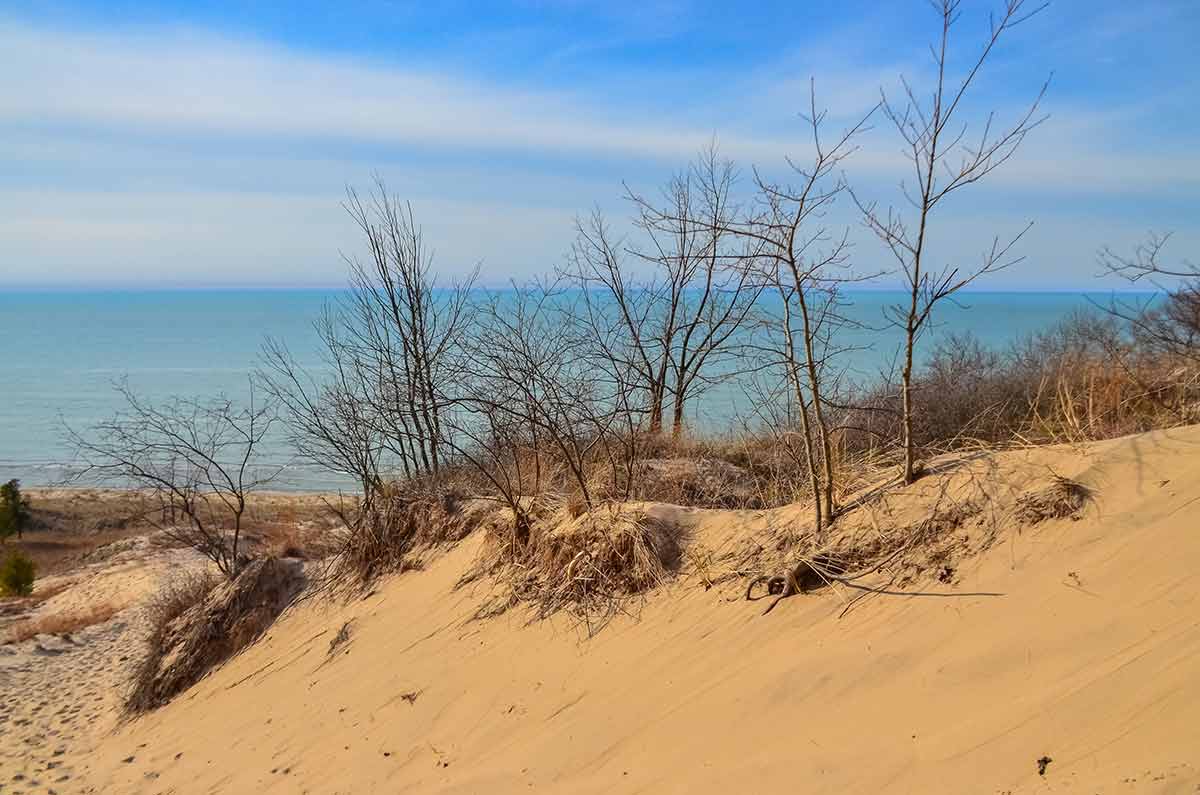
Getting to Indiana Dunes National Park is easy with its proximity to Chicago.
Simply fly into one of the three airports in Chicago and drive southeast on I-294 or I-90, and within an hour, you’ll be at the entrance to the park.
Indiana Dunes National Park is at 1215 SR-49, Porter, Indiana 46304
2- George Rogers Clark National Historical Park
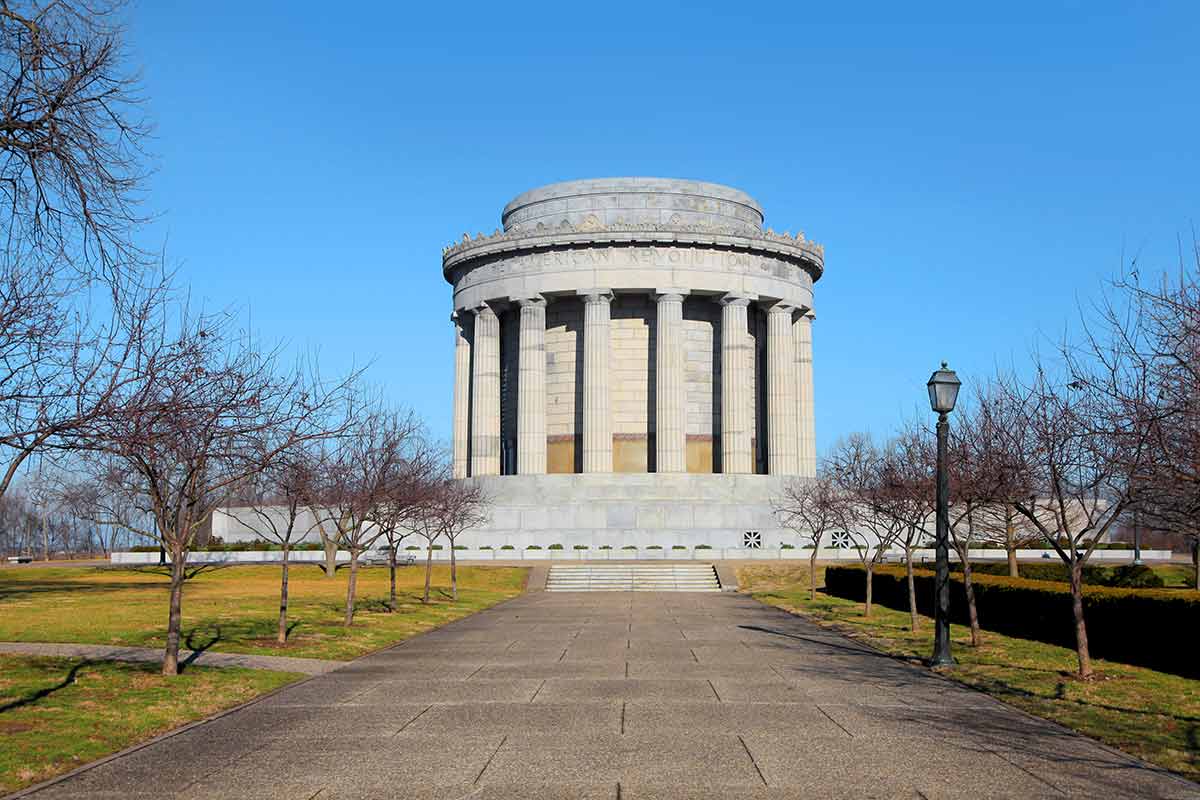
This is the site of one of the greatest feats of the American Revolution.
The George Rogers Clark National Historical Park is full of history, exciting stories and unique structures.
When visiting, you’ll learn the details of George Rogers Clark’s march from Kaskaskia to the site of Vincennes (the site of the Historical Park) and how he and his men were able to claim victory for Fort Sackville and surrounding territories, which became the states of Ohio, Illinois, Indiana, Michigan and Wisconsin.
Today, George Rogers Clark National Historical Park sits on 24.3 acres (9.8 hectares) of land and is home to a Visitor Center, an impressive monument and other smaller statues.
Things To Do In George Clark National Historical Park
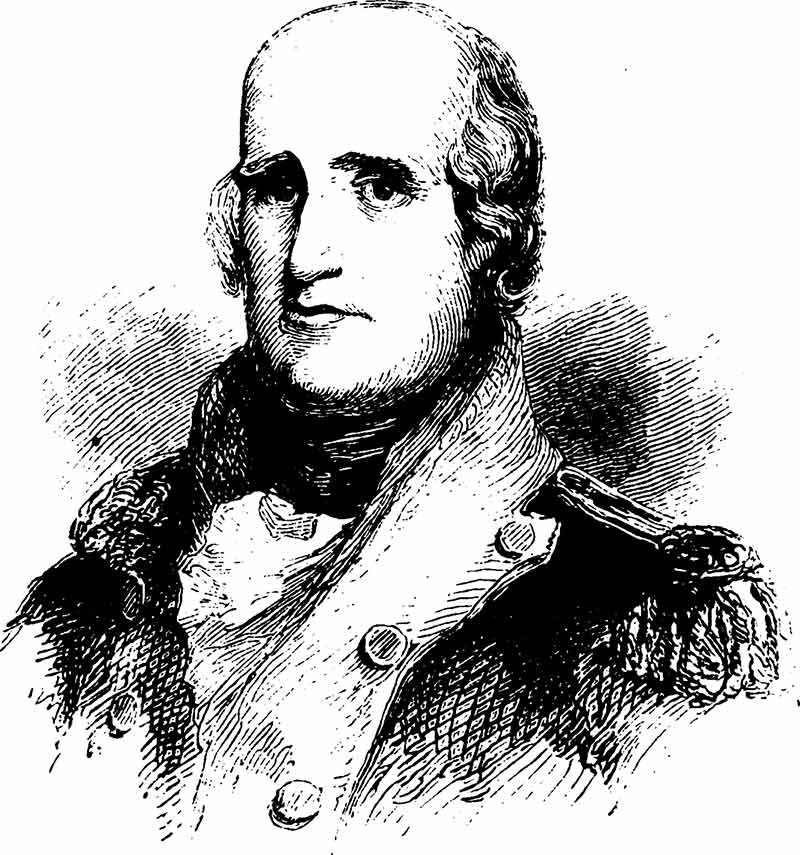
Start your trip to the George Clark National Historical Park with a stop at the Visitor Center.
Here you can watch a 30-minute movie detailing the story of George Rogers Clark and his military campaign.
Also, in the Visitor Center is a small exhibit area and staff and volunteers who are happy to answer questions.
Next up, a short walk will take you to the largest national monument outside Washington, D.C. – the George Rogers Clark Memorial.
On the outside, the memorial takes on Greek influence with 16 granite columns placed perfectly in a circle.
Inside, discover a bronze statue of a young Clark and seven murals showcasing the Clark expedition story.
Besides the Visitor Center and Memorial, there isn’t much to explore at the Historical Park.
If you can extend your visit, it’s worth taking the time to stroll around and check out other statues honouring brave men of the Revolutionary War.
The nearby town of Vincennes is also a great place to stop for an afternoon, with a charming downtown alive with unique shops, antique stores and cosy restaurants.
How To Get To George Rogers Clark National Historical Park
Located along the Wabash River in southwestern Indiana, getting to the George Rogers Clark National Historical Park will take some driving.
Indianapolis and Louisville are the two closest cities with major airports, with Indianapolis being a two-hour drive away and Louisville being a two-and-a-half-hour drive.
George Rogers Clark National Historical Park is at 401 S. 2nd Street, Vincennes, IN 47591
3- Lincoln Boyhood National Memorial
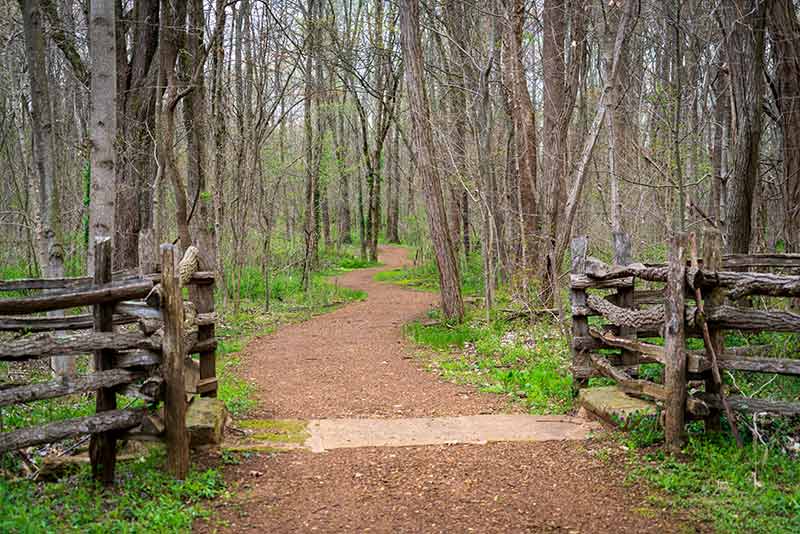
As its name suggests, the Lincoln Boyhood National Memorial preserves the 200-acre (81-hectares) farm site where Abraham Lincoln lived from age seven to 21.
The Lincoln Living Historical Farm, a Visitor Center, a cemetery, a museum and a few short walking trails are included in the National Memorial.
It’s a great place to spend an afternoon if you’re in the area. However, as the National Memorial is relatively small, you’ll be able to explore the grounds in just an hour or two.
Things To Do In The Lincoln Boyhood National Memorial
As the main focus of the Lincoln Boyhood National Memorial is to protect the land and structures where Abraham Lincoln grew up, the things to do mainly centre around seeing and learning about Abraham’s childhood and early adult years.
Stop in at the Visitor Center to watch a short film about the National Memorial and Abraham’s upbringing, check out a small museum or pick yourself up a souvenir in the bookstore.
Next up, wander around the grounds to see a replica of the cabin Abraham grew up in, the pioneer cemetery where Abraham’s mother and 27 other settlers were buried, and the Lincoln Spring, where the family accessed fresh water.
Also on the grounds are over two miles of hiking trails.
The most popular trail is the Boyhood Trail, which connects the Pioneer Cemetery to the Living Historical Farm.
Then, continue on the Trail of Twelve Stones, which loops back to the cemetery for a pleasant one-mile walk.
If you’re lucky, you may also have the opportunity to see the farm come to life.
Over the summer months, volunteers reenact life in the 1820s and give farming and cooking demonstrations.
The Lincoln Boyhood National Memorial is much quieter in winter, but the winter frost brings a new beautiful charm to the region.
How To Get To The Lincoln Boyhood National Memorial
The Louisville International Airport is the closest major airport to Lincoln Boyhood National Memorial.
From here, it’s an hour and a half drive along I-64 to reach the memorial in southern Indiana.
Lincoln Boyhood National Memorial is at 3027 E S St, Lincoln City, Indiana 47552
4- Lewis & Clark National Historic Trail
Stretching 4,900 miles (7885 kilometres) long through 16 states, the Lewis & Clark National Historic Trail is one of the most famous historic trails in the United States.
The trail follows the path of Lewis and Clark’s Corps of Discovery trip between 1804 and 1806, when the duo travelled from St. Louis, Missouri to the mouth of the Columbia River in present-day Oregon.
The trail now also includes Lewis & Clark’s preparatory trips along the Ohio River to Pittsburgh.
Today, much of the trail is alongside country roads and busy highways, making it difficult and unpleasant to hike the complete trail.
However, if you know where to look, you can hike, paddle or backpack well off the road and across stunning landscapes.
Things To Do On The Lewis & Clark National Historic Trail
The best place to experience the Lewis & Clark National Historic Trail in Indiana is at Ohio State Park Falls in the southeast corner of the state.
Interestingly, the main feature of this park has little to do with the Lewis & Clark expedition and instead highlights the 390-million-year-old fossil beds found here.
To learn more about the fossils, be sure to visit the interpretive centre or collect some of your own fossils from the quarries in the parking lot behind the interpretive centre, where you can dig for your own.
Other great spots to check out along the Lewis & Clark National Historic Trail include:
The Ohio County Historical Museum
Stop in and check out the interesting collection of 1800s and 1900s artefacts, including the famous race boat HOOSIER BOY and the first coin-operated music player.
George Rogers Clark Home Site
Part of the Falls of the Ohio State Park, George Rogers Clark Home Site preserves the location where George Rogers Clark, a revolutionary war general, spent his retirement years.
Unfortunately, the replica cabin recently burned down in 2021, but it’s still nice to explore the grounds.
Oak Hill Cemetery and Arboretum
Located in Evansville, the Oak Hill Cemetery and Arboretum houses the graves of 500 Union men, 24 Confederate soldiers and 98 local men.
Here, you’ll also find lovely green spaces to enjoy and an arboretum filled with local and exotic tree species.
Rising Sun Riverfront Park
In the small town of Rising Sun, you’ll come across one of the most charming riverfront parks on the Ohio River.
Grab yourself a snack from a downtown shop and join the locals watching boats and barges meander lazily down the river.
Time your visit right to catch the annual catfish tournament or Navy Bean Fall Festival.
How To Get To The Lewis & Clark National Historic Trail
As the Lewis & Clark National Historic Trail stretch along a large portion of the Indiana and Kentucky border, there’s no one spot to pinpoint on the map.
However, if you’d like to start your exploration at the Falls of Ohio State Park, head to 201 W Riverside Dr, Clarksville, Indiana 47129.
If you love exploring national parks, you might like to read:
- Wyoming National Parks Guide
- Nevada National Parks Guide
- Michigan National Parks Guide
- 5 Maine National Parks
- New Hampshire National Parks Guide
- 25 National Parks in Canada
- 17 National Parks in Argentina
- Tasmania National Parks
- 20 National Parks in Mexico
- 18 New Mexico National Parks
- 18 National Parks in Massachusetts
- 17 Colorado National Parks
- 4 Indiana National Parks
- 5 Nebraska National Parks
- 30 Virginia National Parks
- 9 New Jersey National Parks
- 8 National Parks in Arkansas
- 8 Alaska National Parks
- 13 Tennessee National Parks
- 6 National Parks in Louisiana
- 5 Illinois National Parks
- 7 National Parks in Oklahoma
- 7 National Parks in South Dakota
- 12 Alabama National Parks
- 5 North Dakota National Parks
- 8 National Parks in West Virginia
- 20 National Parks in Arizona
- 11 National Parks In Florida
- 8 Hawaii National Parks
- 6 National Parks In Idaho
- Texas National Parks Guide
- 9 California National Parks
- 11 National Parks In Georgia
- 7 National Parks In Missouri
- 5 National Parks in Minnesota
- 7 National Parks In Kentucky
- 8 National Parks In Montana
- 15 National Parks In Washington State
- 8 South Carolina National Parks
- 12 North Carolina National Parks
- 4 Wisconsin National Parks
- 20 National Parks In India
- 11 Oregon National Parks
- 5 Connecticut National Parks
- 27 National Parks In New York State
- 4 Iowa National Parks
- Yosemite National Park
- Zion National Park
- 21 National Parks in Pennsylvania
- 9 National Parks in Mississippi
- 5 National Parks in Rhode Island
- 9 National Parks in Taiwan
- 20 East Coast National Parks
- Guide To Winter in Yellowstone National Park
Plan Your Trip

Rent A Car – Find the best car rental rates at Discover Cars. They compare car hire companies to provide you with the best deal right now.

Find A Hotel – If you’re curious about this article and are looking for somewhere to stay, take a look at these amazing hotels.





